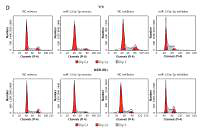Current issue
Archive
Manuscripts accepted
About the Journal
Editorial office
Editorial board
Section Editors
Abstracting and indexing
Subscription
Contact
Ethical standards and procedures
Most read articles
Instructions for authors
Article Processing Charge (APC)
Regulations of paying article processing charge (APC)
ONCOLOGY / BASIC RESEARCH
miR-133a-3p promotes apoptosis and induces cell cycle arrest by targeting CREB1 in retinoblastoma
1
Department of Ophthalmology, The Affiliated Huaian No. 1 People’s Hospital of Nanjing Medical University, Huai’ an, Jiangsu, China
Submission date: 2018-11-08
Final revision date: 2018-12-18
Acceptance date: 2018-12-25
Online publication date: 2019-07-25
Publication date: 2020-05-26
Arch Med Sci 2020;16(4):941-956
KEYWORDS
TOPICS
ABSTRACT
Introduction:
Retinoblastoma (RB) is a malignant tumor that is derived from photoreceptors. It is common in children under 3 years old with a family genetic predisposition. MicroRNA-133a-3p (miR-133a-3p) is one of the tumor-related miRNAs that interprets a critical function in the genesis and development of various tumors. This study investigated the effects and underlying mechanisms of miR-133a-3p in RB.
Material and methods:
Quantitative reverse-transcription polymerase chain reaction (qRT-PCR) analysis was used to assess the miR-133a-3p expression in RB tissues and a cell model. MTT assay, western blot, flow cytometry and luciferase reporter assay were performed to evaluate the effect of miR-133a-3p on cell viability, apoptosis and the cell cycle. An RB xenograft model was established to assess the in vivo influence of miR-133a-3p on RB growth.
Results:
MiR-133a-3p level was reduced in RB tissues and the cell model (p < 0.01 or p < 0.001). Addition of miR-133a-3p reduced cell viability, and increased apoptosis and cell cycle arrest (p < 0.001). Additionally, CREB1 was identified to be the target of miR-133a-3p in RB cell lines (p < 0.001). Cell viability reduction, apoptosis and cell cycle arrest increases mediated by miR-133a-3p were attenuated by CREB1 overexpression (p < 0.001). MiR-133a-3p inhibited tumor growth of RB in vivo (p < 0.001).
Conclusions:
Our results reveal that miR-133a-3p exhibits anti-cancer effects by targeting CREB1 in RB. This study provides a new direction for effective targeted treatment of this disease.
Retinoblastoma (RB) is a malignant tumor that is derived from photoreceptors. It is common in children under 3 years old with a family genetic predisposition. MicroRNA-133a-3p (miR-133a-3p) is one of the tumor-related miRNAs that interprets a critical function in the genesis and development of various tumors. This study investigated the effects and underlying mechanisms of miR-133a-3p in RB.
Material and methods:
Quantitative reverse-transcription polymerase chain reaction (qRT-PCR) analysis was used to assess the miR-133a-3p expression in RB tissues and a cell model. MTT assay, western blot, flow cytometry and luciferase reporter assay were performed to evaluate the effect of miR-133a-3p on cell viability, apoptosis and the cell cycle. An RB xenograft model was established to assess the in vivo influence of miR-133a-3p on RB growth.
Results:
MiR-133a-3p level was reduced in RB tissues and the cell model (p < 0.01 or p < 0.001). Addition of miR-133a-3p reduced cell viability, and increased apoptosis and cell cycle arrest (p < 0.001). Additionally, CREB1 was identified to be the target of miR-133a-3p in RB cell lines (p < 0.001). Cell viability reduction, apoptosis and cell cycle arrest increases mediated by miR-133a-3p were attenuated by CREB1 overexpression (p < 0.001). MiR-133a-3p inhibited tumor growth of RB in vivo (p < 0.001).
Conclusions:
Our results reveal that miR-133a-3p exhibits anti-cancer effects by targeting CREB1 in RB. This study provides a new direction for effective targeted treatment of this disease.
Share
RELATED ARTICLE
We process personal data collected when visiting the website. The function of obtaining information about users and their behavior is carried out by voluntarily entered information in forms and saving cookies in end devices. Data, including cookies, are used to provide services, improve the user experience and to analyze the traffic in accordance with the Privacy policy. Data are also collected and processed by Google Analytics tool (more).
You can change cookies settings in your browser. Restricted use of cookies in the browser configuration may affect some functionalities of the website.
You can change cookies settings in your browser. Restricted use of cookies in the browser configuration may affect some functionalities of the website.



